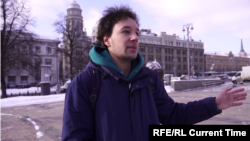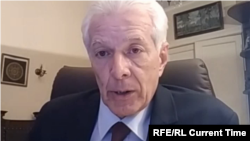Riot police in Moscow made heavy use of truncheons to detain hundreds of people during recent unauthorized rallies for the release of Russian opposition leader Aleksei Navalny from prison, but they also are employing a more sophisticated tool: the city’s tens of thousands of surveillance cameras that allow them to identify suspected participants even after demonstrations are over.
The cameras can be found at nearly every major intersection in this metropolis of over 12 million. As of March 2020, approximately 70 existed for each square kilometer, for an overall total of 178,000, according to the Moscow mayor’s office.
That number likely increased during this year’s January 23, January 31, and February 2 pro-Navalny protests. During such demonstrations, police routinely bring in unmarked white vans with cameras high atop poles to surveil crowds.
The technology, though, depends on accurate human interpretation. Journalists simply covering the January 23 Navalny protests now have added to the estimated 1,558 people who were detained in Moscow as suspected demonstrators.
On January 31, a police officer turned up at the apartment of freelance camera operator Georgy Malets’ parents to detain him for supposedly taking part in the January 23 protests. Not finding him at home, they managed to trace him to a subway station.
“We went through the turnstile, went down the escalator, and right at the bottom of the escalator, five to six police officers are standing,” Malets recounted. “They say, ‘You’re detained.’ I say, ‘What’s the deal?’ They answer, 'We need to check whether you’re under criminal investigation.’”
Malets told Current Time that he explained that he is a journalist and showed his assignments to the police. The officers explained, he added, that they had found him from camera footage of Moscow’s January 23 protest. He was later released.
With the help of these cameras, police on January 31 also detained Kamil Galeyev, author of the history-focused Telegram channel Vysokaya Porta (Sublime Porte), on similar grounds. Galeyev has been sentenced to 10 days in jail, said his lawyer, Mikhail Biryukov.
“Matching the photo [from the camera] on the street with the [police] database, you can always find a specific person who was in a given location, and take these repressive measures,” commented Biryukov. “I can’t call it anything else: This is repression.”
Police have access to any photos provided for government-issued identification cards as well as the relevant address for an individual’s official registration for living in Moscow.
In compliance with government regulations, the Russian social network VKontakte (In Contact) provides the authorities with information about all of their estimated 639 million registered users. Biryukov charges that photos from the platform, including those concealed from unauthorized users, are added to the Moscow city police’s facial-recognition-camera database.
“It’s as if a user of VKontakte is on full display before the law-enforcement organs,” commented Biryukov.
One Russian company, NtechLab, supplies Russia’s Interior Ministry and the Moscow Information Technologies Department with facial-recognition software first developed its application by analyzing VKontakte avatars. Government offices now constitute the primary customers for NtechLab’s FindFace application, commented company head Aleksandr Minin in a 2019 interview with Current Time.
The city of Moscow also has used facial-recognition software as part of its monitoring of those under quarantine for COVID-19. Following the initial unauthorized protest on January 23 for Navalny's release from prison, the Moscow Health Department announced that 19 individuals had violated their quarantines to attend the gathering in Moscow.
Those individuals previously known to the authorities also seem to feature among the AI-assisted detentions. Activist Sergei Abanichev, imprisoned for alleged involvement in Moscow’s 2019 election protests, was detained at the Timuryazevskaya subway station, even though Abanichev claimed that he had spent the day of the January 23 protest outside of the city.
Plans exist to try out Мoscow's surveillance system also in 10 other Russian cities, the daily Kommersant reported in September 2020.
Russia, though, is far from the only country using the cameras. China arguably ranks as the best known early adopter, but the devices monitor airports, train stations, public facilities, and streets throughout the world.
In the United States, the FBI is using facial-recognition software, which compares photos with images culled from Google and social media sites, to identify participants in the January 6 storming of the U.S. Capitol, reported IEEE Spectrum, the magazine of IEEE, a U.S.-based international organization for technology professionals. Amidst privacy concerns, however, some U.S. cities have banned the use of the technology.
Citing the risk of violations of human rights, the Council of Europe, the continent's largest rights watchdog, has urged European legislatures to regulate the technology more strictly. Amidst growing pressure for a ban, the European Union in 2020 opted to leave such measures up to its 26 member states.
But Moscow Mayor Sergei Sobyanin maintains that the cameras only enhance the public's safety. “The situation in many of the world’s cities is extremely complicated and leads to crime,” Sobyanin observed in December 2020 in response to a question from opposition City Council deputy Darya Besedina about the Russian capital's surveillance cameras. “And Moscow, on this count, looks significantly better and safer. The system of video surveillance plays a large role in this.”
Writing in October 2020, however, the international rights monitor Human Rights Watch challenged such public-safety arguments.
“Russia’s track record of rights violations means that the authorities should be prepared to answer tough questions to prove they are not undermining people’s rights by pretending to protect public safety,” contended Hugh Williams, the non-profit organization’s Europe and Central Asia director.
Attorney Biryukov, though, believes that Russian law enforcement using surveillance to keep tabs on the general public already has become a fait accompli.
“We’re now in a situation in which any one of our steps leaves traces not only in social networks, but also in the special services’ archives,” he noted. “And these archives can always be brought up and used to prosecute someone on criminal charges. This is the new reality in which we live.”
-With additional reporting from CNET, The Financial Times, and TASS

















